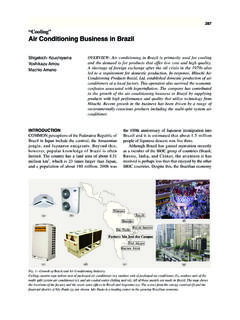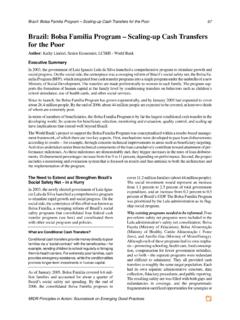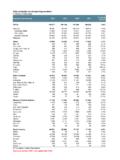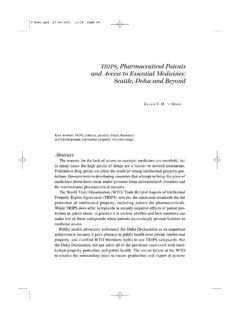Transcription of Country Report – Brazil
1 1 Assessment of Child Maltreatment Prevention Readiness Country Report Brazil 2012 Nancy Cardia Pedro Lagatta Claudinei Affonso NEV University of Sao Paulo 2 About the Center for the Study of Violence (NEV) The Center for the Study of Violence of the University of S o Paulo (NEV/USP) is one of the Research Support Centers of USP. Since 1987, NEV has been developing researches and training researchers having as one of its main features the interdisciplinary approach in discussing the relationships between violence, democracy and human rights. Throughout its 20 years of existence, NEV has developed a series of research projects and extension programs funded by the Ford Foundation, the Rockefeller Foundation, the International Committee of the Red Cross, CNPq and FAPESP, and has also entered into agreements with UN agencies (WHO/PAHO, UNDP), European Union, and in Brazil , with the Ministries of Health and Justice and the Secretariat of Human Rights.
2 Currently NEV/USP is engaged in investigating what kind of democracy and governance is being developed in Brazil , especially considering the current context where: gross human rights violations persists; territories are dominated by the organized crime; the presence of corruption is systemic; homicide rates are still high; impunity is high; access to some civil rights is limited; the culture of human rights, supportive to the Rule of Law, is often absent. To meet these challenges, the studies conducted by NEV seek: to monitor both violations and policies and programs to promote human rights; to identify and understand continuities and changes in society and in the State on issues relating to democracy, violence and human rights, focusing particularly in which Rule of Law emerges from these relationships, what kind of transparency and responsiveness are being consolidated and how these factors affect the perception and public support for a democratic system and for the respect for human rights.
3 In October 2000, NEV/USP was awarded with FAPESP s Special Program, becoming one of the ten Research, Innovation and Diffusion Centers (CEPID). As a CEPID, NEV s functions of research and intervention became more institutionalized, establishing to this end a line of action that puts together the vocation of scientific research center with the growing experience of intervention, whether in training human resources qualified to the professional work in judicial and promotion of human rights agencies, and in the formulation and implementation of public policies for human rights and violence decrease. 3 Since it is one of the Research Support Centers of USP and participates in the project CEPID/FAPESP, NEV was selected in 2011 to join the Research Incentive Program of the Dean of Research of USP.
4 This is a supplementary financing program that seeks to strengthen competitive and highly specialized research groups which act synergistically and that form qualified human resources. To participate in this Research Incentive Program and aiming to broaden and deepen its researches, NEV has established partnerships with the departments of Sociology, Anthropology, Preventive Medicine (Medical School) and Philosophy and Theory of Law (Law School). NEV also hosts the National Institute of Science and Technology (INCT) Violence, Democracy and Citizen Security, coordinating a collaborative action between six national centers of excellence around a common agenda for research in the areas of violence, democracy, public safety and human rights, covering four of the five Brazilian macro-regions.
5 More information available at our institutional website: 4 Table of Contents 1. Background .. 5 2. Aims and objectives of the Project ..10 3. Target Audience/readership for this Report /research ..11 4. Method ..12 5. 6. Strategies and Challenges to increase CMP readiness..49 7. Limitations of the Study in Brazil ..55 8. Conclusions ..56 9. Appendix ..58 10. Literature Review ..62 11. References ..70 5 1. Background Though children still represent a considerable part of the Brazilian population, policies for the promotion of healthy early child development and/ or the prevention child maltreatment are still very incipient and/or non-existent. This gap suggests that the Country is not responding to what is being stressed by different fields of knowledge, about the importance of a child s early years in defining the quality of life that this child will have as an adult, in particular that.
6 A) neurological, behavioral and social science research over the past decades has produced major advances in understanding the conditions that influence whether children grow up to become aggressive, anti-social individuals prone to repeat acts of violence, or self-controlled b) outcome evaluation studies of programs to enhance early childhood development have identified interventions that are effective or show great promise in reducing the conditions that produce negative development outcomes, and the frequency of anti-social and violent behavior in life. c) cost-effectiveness studies, most of which conclude that interventions to prevent early childhood adversities and violence save substantially more money than they cost.
7 D) consequences of childhood adversity and violence are so far-reaching as to threaten the nation s human capital formation and undermine the (Fetzer research program, 2009, mimeo) Brazilian policies for children have mostly focused on the prevention of infant and child mortality. Having had much success at this effort such policies have not progressed to include the improving of the quality of life for children by, for instance, promoting healthy development and preventing maltreatment. 6 The 2010 Census revealed that Brazil had at that time more than 62 million children (under 19 years of age). This represents a third of the Brazilian population. In the last 25 years, the Country witnessed a substantial reduction in the fertility rate, but similarly to other countries this drop is not homogeneous: for poorer families or those living in rural areas the reduction was smaller.
8 There was also in this period, a large reduction in the mortality rate of children under five years: from almost 60 per 1000 children in 1990 to 33 per 1000 in 2006 (IPEA, 2010). Despite this reduction risk factors for maltreatment and abuse continue to exist, and there are indicators that they may have become more poignant for vulnerable groups. Twenty five percent of children live in a one parent family, and of the 75% living with two adults it is not known how many live with both parents or with step parents. In 2006, the most recent year for which data is available, 10% of children born were under the expected weight at birth (less than kg), presented chronic malnourishment and acute malnourishment.
9 Violence and traffic accidents are the main causa mortis of children in the decade of 1990. Though this decade, the death per 1000 inhabitants have presented a small decrease, from in 1990 to in 2000 and the number of children that died due violence is still high: almost deaths of children from 1 to 9 years old in 2000 (MINIST RIO DA SA DE, 2005). Less is known about morbidity, there is no child victimization survey or epidemiological surveillance of victimization in course to assess maltreatment. The little information available suggests the problem is indeed serious: data collected from 314 municipalities (out of 5564) across the Country revealed that in the second semester of 2005 alone, children received attention from the Social Welfare Centers: either because of sexual abuse ( ), psychological violence ( ), neglect ( ), physical violence ( ) and sexual exploitation ( ).
10 Most victims were in the 7-14 years group ( ) remarkably were under 6 years old. (MINISTERIO DO DESENVOLVIMENTO SOCIAL, 2006). Legislation on child maltreatment The Brazilian legislation concerning the protection of the child (Statute of the Child and the Adolescent- ECA) is deemed to be one of the most advanced in the world. It reflects the ratification by Brazil of the UN Convention on the Rights of the Child, being based on the principle of full protection and the changes brought to the Country by a New Constitution (1988) that marked the return of the Country to a democratic regime. The 7 Statute of the Child and the Adolescent came into effect in July 1990 and reflects the ratification of the Optional Protocol and the adherence to the UN Minimum Rules for the Administration of Juvenile Court (Beijing Rules), the UN Minimum Rules for the Protection of juveniles in Detention, and the Riyadh Guidelines.

















